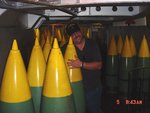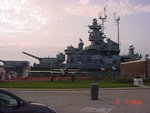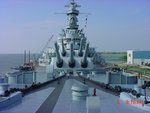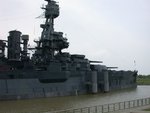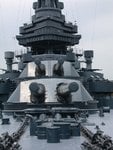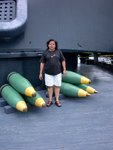Navigation
Install the app
How to install the app on iOS
Follow along with the video below to see how to install our site as a web app on your home screen.
Note: This feature may not be available in some browsers.
More options
You are using an out of date browser. It may not display this or other websites correctly.
You should upgrade or use an alternative browser.
You should upgrade or use an alternative browser.
Last of the Battleships?
- Thread starter Thorlifter
- Start date
Ad: This forum contains affiliate links to products on Amazon and eBay. More information in Terms and rules
More options
Who Replied?Njaco
The Pop-Tart Whisperer
Is that you in the first pic?
Mugshot thread!!!
Mugshot thread!!!
The Iowa class battleships were surrounded by a support group like the carriers and they weren't just drug out of mothballs and put back to sea, they were modernized. This included upgraded electonics warfare capability and enhanced targeting/fire control for the barreled weapons. In addition, they received modernized defensive/offensive weapon upfits.
This included:
(4) MK 141 quad cell launchers for 16 AGM-84 Harpoon anti-ship missiles
(8) Armored Box Launcher mounts for 32 BGM-109 Tomahawk cruise missiles
(4) Phalanx Gatling guns
They were also equipped with 40mm grenade launchers as well as 25mm chain-guns to ward off attackers in a close quarter bartle.
During the Gulf War, the Missouri came under attack by anti-shipping missiles (silkworm), which were intercepted by her support group while she was pounding Iraqi shore positions.
I was aware of the modernizations to the weapons platform of the Missouri. IMO though it was a very expensive platform, it could have been done far cheaper by a number of smaller vessels. And you are putting all these weapons on one ship, which makes the sinking of such a ship a huge morale boost for the enemy.
But my big point - the battleship as sent to war in the Gulf was sent as predominantly a shore bombardment vessel. While this was not unusual for the battleship in WW2, the big difference to me as that in it's heyday, a battleship was sent to attack other surface threats - it was not to be protected from other surface threats by a task force.
Look at WW2 - the battleship, even though past it's prime as a weapon of war was used to defend carriers from air attacks with it's large amount of 5" guns and other anti aircraft batteries. It was also used to either protect the carriers against opposing surface forces, or to seek out opposing surface forces for combat.
In the gulf, the battleship was a shore bombardment weapon protected from opposing surface threats by it's task force.
vikingBerserker
Lieutenant General
Man, I wish I had my pics of the USS North Carolina!
GrauGeist
Generalfeldmarschall zur Luftschiff Abteilung
That's how the majority of U.S. battleships operated in the pacific, during WWIIIn the gulf, the battleship was a shore bombardment weapon protected from opposing surface threats by it's task force.
In all honesty, the bulk of material a battleship can carry far surpasses a modern missile frigate/cruiser and it can be use offensively against an enemy surface fleet, it's just not been tried in the late 20th century
- Thread starter
- #46
Thorlifter
Captain
The Iowa class battleships were surrounded by a support group like the carriers and they weren't just drug out of mothballs and put back to sea, they were modernized. This included upgraded electonics warfare capability and enhanced targeting/fire control for the barreled weapons. In addition, they received modernized defensive/offensive weapon upfits.
This included:
(4) MK 141 quad cell launchers for 16 AGM-84 Harpoon anti-ship missiles
(8) Armored Box Launcher mounts for 32 BGM-109 Tomahawk cruise missiles
(4) Phalanx Gatling guns
They were also equipped with 40mm grenade launchers as well as 25mm chain-guns to ward off attackers in a close quarter bartle.
During the Gulf War, the Missouri came under attack by anti-shipping missiles (silkworm), which were intercepted by her support group while she was pounding Iraqi shore positions.
A battleship is not a totally helpless target, just waiting for something to fall out of the sky and sink it. It's a capable weapon platform than can perform a wide range of functions.
I think that is a great point GG. If you can have a mobile weapons platform that can fire 16 Harpoons to eliminate threats, plus 32 Tomahawks to destroy targets of value, plus help defend the fleet with AA to 16" weapons, plus provide shore bombardment, that is a versatile, valuable weapon.
Obviously the navy doesn't think so since it is going towards smaller, stealth, less costly ships.
Glider
Captain
The Iowa class battleships were surrounded by a support group like the carriers and they weren't just drug out of mothballs and put back to sea, they were modernized. This included upgraded electonics warfare capability and enhanced targeting/fire control for the barreled weapons. In addition, they received modernized defensive/offensive weapon upfits.
This included:
(4) MK 141 quad cell launchers for 16 AGM-84 Harpoon anti-ship missiles
(8) Armored Box Launcher mounts for 32 BGM-109 Tomahawk cruise missiles
(4) Phalanx Gatling guns
They were also equipped with 40mm grenade launchers as well as 25mm chain-guns to ward off attackers in a close quarter bartle.
During the Gulf War, the Missouri came under attack by anti-shipping missiles (silkworm), which were intercepted by her support group while she was pounding Iraqi shore positions.
A battleship is not a totally helpless target, just waiting for something to fall out of the sky and sink it. It's a capable weapon platform than can perform a wide range of functions.
I have to disagree. The Missouri is a vital target that has to depend on its point defence systems and escort to achieve anything and I don't think it can perform many missions. Fire Support is the obvious one but little if anything else and even that is limited to the range of the guns. It isn't an air defence system neither can it protect against submarines, to defend against missile or air attack there are a number of AEGIS type systems that are far more effective and it detracts from the defence of other vessels in the area as she is a huge target that would need protection itself.
The point about the silkworm attack proves the point, she was attacked by a basic simple obsolete missile that almost got through the defences. The silkworm was shot down by an RN Sea Dart which was basically the last throw of the dice as a defence as it wasn't designed as an anti missile weapon, the dedicated CIWS defences having missed the Silkworm in the first place.
Last edited:
The point about the silkworm attack proves the point, she was attacked by a basic simple obsolete missile that almost got through the defences. The silkworm was shot down by an RN Sea Dart which was basically the last throw of the dice as a defence as it wasn't designed as an anti missile weapon, the dedicated CIWS defences having missed the Silkworm in the first place.
Although in defense of the battleship, a silkworm hit is going to do almost nothing to it, at least I mean it's not going to in any way cause it to sink.
The silkworm won't penetrate the armored belt, it may take out a sensor or knock out one of the missile launchers and cause some casualties, but that is about it.
I think as current weapons are for the most part not designed for taking out battleships, they are reasonably safe. However it would not be too difficult to design weapons designed to take out heavily armored ships - it would just have to be designed.
Glider
Captain
While I agree that one missile will not sink her I wouldn't write off the damage a 395KG warhead with semi armour piercing warhead will do to the upper decks. The main point was that the presence of the BB makes it a target that will need defending while adding little if anything to the defence. This will reduce the defences available to the rest of the fleet.
parsifal
Colonel
Cruise missiles have certain enhancers or firepower multiplier effects. Silkworms are notoriously innaccurate. however they aree old and obsolete as well. More modern and capable weapons confer certain inherent advantages . The placements of the missile, it can attack at the waterline, or up high, it can utilize a diving attack using a 600 knot power dive. It can be fired "hot" meaning its tries to maximise the risk of fire, or AP for armour pentration . Short answer is that a missile hit is a far more serious threat than its mere shell weight might suggest
he main point was that the presence of the BB makes it a target that will need defending while adding little if anything to the defence. This will reduce the defences available to the rest of the fleet.
Yes, Agree 100% here.
The placements of the missile, it can attack at the waterline, or up high, it can utilize a diving attack using a 600 knot power dive. It can be fired "hot" meaning its tries to maximise the risk of fire, or AP for armour pentration . Short answer is that a missile hit is a far more serious threat than its mere shell weight might suggest
I'm not trying to trivialize the effects of a missile hit. But take a look at the USS Stark - about a 4,000 displacement vessel, no real armor. It was hit by two extocet missiles, that are about 80% the size of the Harpoon missile. It took damage of course, but got the list and fires quickly under control.
Of course a 3600 ton british destroyer (Sheffield) was hit by one and sunk. This was in 1982, ships have gotten a bit more surviveable since then. It was a fire that went out of control.
But look at something like the Musahi - 19 torpedoes, 17 bombs (1000 pounds each, 350-550 pounds of explosives, depending upon type, I.e. SAP, GP, etc/). A Harpoon type missile hits far more accurately than a bomb, but it's destructive power is roughly similar to that of a 500 pound bomb, or a 14 inch artillery shell.
And yes, you can make them more armor piercing, but you do so at the expense of explosive filler. you can hit the deck armor with that pop up you mention, but that's 6-7" of deck armor, still very difficult to penetrate.
Again, not that a battleship is invulnerable, but modern weapons are not design for taking on behemoths with 12"+ Belt armor and 6-7" of deck armor. I forget which navy study this is based upon, but an explosion was considered 3 times as dangerous if the shell/bomb was able to pierce the armor. Most modern weapons don't stand much of a chance of piercing the armor of a battleship like the New Jersey class.
GrauGeist
Generalfeldmarschall zur Luftschiff Abteilung
Technically, anything from a tugboat to a carrier can be considered a target. Aside from the compliment of aircraft, a carrier can only defend itself so much, being reliant on it's support vessels to aid in defense....The main point was that the presence of the BB makes it a target that will need defending while adding little if anything to the defence. This will reduce the defences available to the rest of the fleet.
The Battleships in the Gulfwar were deployed in a multi-role mission, one of which did include shore bombardment. They also were prepared to engage hostile shipping, lent support with inland strikes via cruise missiles, etc.But my big point - the battleship as sent to war in the Gulf was sent as predominantly a shore bombardment vessel. While this was not unusual for the battleship in WW2, the big difference to me as that in it's heyday, a battleship was sent to attack other surface threats - it was not to be protected from other surface threats by a task force.
On occasion, it fell to the Cruisers to protect the Carriers and there were several examples in the PTO where Cruisers engaged enemy forces acting on behalf of absent Battleships.Look at WW2 - the battleship, even though past it's prime as a weapon of war was used to defend carriers from air attacks with it's large amount of 5" guns and other anti aircraft batteries. It was also used to either protect the carriers against opposing surface forces, or to seek out opposing surface forces for combat.
And if you look at photos of Battleships in action during WWII, you'll note a huge presense of Cruisers and Destroyers protecting the Battleships as they pounded Japanese held positions...same is said for the Battleship action during the Korean war.In the gulf, the battleship was a shore bombardment weapon protected from opposing surface threats by it's task force.
vikingBerserker
Lieutenant General
I think the thing to remember is typically the BB would not operate by itself (just like CVs and cruisers but instead is part of an overall weapons system including other ships.
I think the only weapon currently out there beyond Nukes that could potentially cause serious harm to a BB is the torpedo that creates a vacuum under a ship leaving the weight support by the bow and stern and thus breaking the back. I think with the armor it has it certainly would withstand this better than any other ship, but if it could completely withstand this or not I do not know.
I think the only weapon currently out there beyond Nukes that could potentially cause serious harm to a BB is the torpedo that creates a vacuum under a ship leaving the weight support by the bow and stern and thus breaking the back. I think with the armor it has it certainly would withstand this better than any other ship, but if it could completely withstand this or not I do not know.
- Thread starter
- #55
Thorlifter
Captain
I was just about to say that VB. Whatever the largest capital ship is in a task force will almost always be the #1 target. Carriers are the biggest and always the #1 target. The Japanese goal at Pearl Harbor was to eliminate the carriers and battleships. No carriers were there so they hit the battleships because they knew what the American BB's could do to their own task forces.
Fast forward 70 years and yes, maybe battleships are an obsolete weapons system due to technology. But if there is a task force and the largest ship is a cruiser, the enemy will target them for largest loss of life, loss of enemy moral from losing a capital ship, and most likely it would be where the task force commander will be. Your larger vessels REQUIRE support ships, but what those large ships can deliver with offense and defense makes them valuable.
Just my opinion.
Fast forward 70 years and yes, maybe battleships are an obsolete weapons system due to technology. But if there is a task force and the largest ship is a cruiser, the enemy will target them for largest loss of life, loss of enemy moral from losing a capital ship, and most likely it would be where the task force commander will be. Your larger vessels REQUIRE support ships, but what those large ships can deliver with offense and defense makes them valuable.
Just my opinion.
I think the only weapon currently out there beyond Nukes that could potentially cause serious harm to a BB is the torpedo that creates a vacuum under a ship leaving the weight support by the bow and stern and thus breaking the back. I think with the armor it has it certainly would withstand this better than any other ship, but if it could completely withstand this or not I do not know.
Any torpedo can really do this - it's about getting it to detonate in the right spot, traditional WW2 tordedoes would strike the sides more instead of the bottom, most being contact fused. There were some designed to detonate beneath, though these had a higher failure rate. And a double hull is about the only"armor" one can expect in this area of the ship.
An underwater explosion like a torpedo, mine or HE bomb near miss function differently than above water explosions. The shock wave ruptures the hull and causes flooding. Some ships have armor to protect from this, a lower belt if the torpedo his fairly high or a torpedo blister if it hits low. Generally only fleet carriers or battleships have this type of protection. But because explosion below water act differently on a ship than those above, near miss bombs were more dangerous to heavily armored battleships than direct hits.
The other thing to about underwater explosions - a few layers of a relatively pliable hull with voided space in between function much better in protecting the ship than a rigid thick armor belt. There are plenty of examples to illustrate this.
You know, I decided to look into various US naval vessels and see what is the equivalent of the rearmed Missouri, at least when it comes to missiles. Surprisingly to me, the modern DDG's can outgun a battleship when it comes to missile complement.
All of this is true, Graugeist.
The point I am trying to make is that every ship has a mission. And the mission of the "Modern Battleship" appears to be primarily shore bombardment. I'd also state that by WW2, particularily in the Pacific, the battleship was on it's way out as an efficient weapon of war. It's big guns were rarely used in an anti-shipping role as designed - they were primarily shore bombardment. The main reason - the aircraft carrier (or more precisely the airplane) was the most effective way of destroying other warships. They outranged the guns on a battleship.
In today's navy, most anti-shipping weapons outrange the Battleship's guns. The biggest culprit is the surface to surface missile, be it Silkworm, Harpoon, Granit, etc. A bit of a comparison between say a Harpoon missile and the 16"/50 BB guns - The Harpoon has a range of about 75 miles to the Battleships 24 or so miles. The Harpoon is far more accurate. The Harpoon has a Bursting charge of 488 pounds vs. About 153 pounds for the Battleships High explosive round. Only advantage I see for the battleship round (other than price) is that it is not subject to countermeasures such as anti-missile missiles, chaff, even the 20mm phalanx at close range. But it has far more accuracy to make up for this. I might add in the defense of the 16" cannon - while it's bursting charge is smaller, it does similar damage as the harpoon due to the kinetic energy of the Shell and it's weight. Bear in mind this is the high explosive round of the 16" gun - the AP round penetrates armor better, but does less actual damage.
The 16" gun (and even smaller cannon like the 5" sported by modern destroyers and cruisers) is much like a modern jets cannon to me. Not useless in the age of missiles, but close iin, cheap, and not subject to countermeasures, but still a secondary weapon certainly to the missiles.
Let's look at the weapons and mission of the rearmed Missouri and their purpose:
(4) MK 141 quad cell launchers for 16 AGM-84 Harpoon anti-ship missiles - 16 anti shipping missiles
( Armored Box Launcher mounts for 32 BGM-109 Tomahawk cruise missiles - I look at this as shore bombardment, even though it has a better "reach"
(4) Phalanx Gatling guns - self defense for the most part
They were also equipped with 40mm grenade launchers as well as 25mm chain-guns to ward off attackers in a close quarter bartle. - again, self defense for the most part. Defending yourself from short range attacks from smaller vessels is not functioning in the anti-shipping role - you are a target defending itself.
16" Gun - Predominant use is shore bombardment
The Missouri carried 48 missiles, 16 of which were anti-shipping, the rest were shore bombardment.
Lets compare to the flight II Ashleigh Burke class destroyer. I'll start by saying I think the destroyer class is a bit of a misnomer, it displaces as much as a small to medium sized cruiser. But, it has 96 missiles on board, and these are a combination of Anti-Sub, Anti-air, close defense anti-air (anti missile actually), and anti shipping. You could load up this destroyer with the 16 Harpoons and 32 Tomahawks, and have room for 48 more missiles, allowing it also to function effectively in the anti-sub and anti-air roles. This is using the Mk 41 Vertical Launching System - really any combination of missiles can be used for many roles.
These destroyers also carry 1 rapid fire 5" cannon, 1-2 20mm Phalanx systems, and a 25mm cannon (most likely for fending off small craft like the 25mm chain guns on the Battleship).
They also carry torpedoes, though these are primarily anti-sub weapons.
So with an Ashleigh Burke Class Destroyer, you have double the missile firepower, and some of the close in defense weapons. All you are really losing are the 16" guns, which take up a lot of space and weight, and have inferior range and accuracy to anti-shipping missiles. And the MK 41 VLS was in service by 1986, well in advance of the Gulf War.
So you are really only losing shore bombardment, and gaining better anti-sub and anti-air capability. Now, the 16" guns provide very effective artillery, but does this effective land to land artillery warrant the cost of a battleship?
The 16" guns on the Missouri are indeed quite effective. they have about 10x the Bursting charge of a 155mm shell (a standard army howitzer), though this does not equate to 10x as effective. There are formulas to determine the effective power of an explosion, but what it amounts to is a 16" shell is about 4x as destructive as a 155mm shell. And a 155mm howitzer has about twice the rate of fire, and a range of about 21 miles (varies by version but using specs for the 155/L55 LHM1A2 Rifled Howitzer).
So the 9 gun broadside brings the effects of about 18 155mm howitzers. I'm not sure though if the 16" shells come in as wide of a variety as the 155mm, so we might be understating the effectiveness of the 155mm.
The redeeming factor in my mind that sending a refitted WW2 Battleship out has - really 2 things. The Ashleigh Burke, other than the 16" Guns outguns the Missouri, and it's capable of more missions, such as effective AA and anti-sub. But it cannot take the punishment the Missouri can. A silkworm would in all likelyhood not sink the Ashleigh Burke, but it would could start fires and cause significant damage. Being struck by 4-5 of these could put the vessel in serious straights.
On the other hand, the Missouri could shrug of these attacks pretty easily. Even a lower belt hit, as Parsifal mentions would have difficulty penetrating the approximate 4" of effective lower belt armor. And you could do different things with shaped charged warheads for instance for better penetration - but this comes at the cost of less true "explosive" damage as in concussive or heat other than the heat used to penetrate the armor. The missouri should be pretty safe against standard modern surface to surface weapons. Unless there were weapons designed specifically for Battleships (good armor piercing abilities along with affective charges) they should stay pretty safe. Torpedoes though are another matter, but modern ASW warfare has come a long way since WW2.
So perhaps as a rough and tumble brawler that can provide cheap shore bombardment it works, but it seems in inefficient use of resources for me, when you can have a 10,000 or so displacement large destroyer that can carry the firepower of the Ashleigh Burke class, compared to the 50,000 or so ton displacement of the Missouri. Maybe I overestimate the cost of operating the Missouri or under estimate the cost of operating a modern destroyer.
Technically, anything from a tugboat to a carrier can be considered a target. Aside from the compliment of aircraft, a carrier can only defend itself so much, being reliant on it's support vessels to aid in defense.
The Battleships in the Gulfwar were deployed in a multi-role mission, one of which did include shore bombardment. They also were prepared to engage hostile shipping, lent support with inland strikes via cruise missiles, etc.
On occasion, it fell to the Cruisers to protect the Carriers and there were several examples in the PTO where Cruisers engaged enemy forces acting on behalf of absent Battleships.
And if you look at photos of Battleships in action during WWII, you'll note a huge presense of Cruisers and Destroyers protecting the Battleships as they pounded Japanese held positions...same is said for the Battleship action during the Korean war.
All of this is true, Graugeist.
The point I am trying to make is that every ship has a mission. And the mission of the "Modern Battleship" appears to be primarily shore bombardment. I'd also state that by WW2, particularily in the Pacific, the battleship was on it's way out as an efficient weapon of war. It's big guns were rarely used in an anti-shipping role as designed - they were primarily shore bombardment. The main reason - the aircraft carrier (or more precisely the airplane) was the most effective way of destroying other warships. They outranged the guns on a battleship.
In today's navy, most anti-shipping weapons outrange the Battleship's guns. The biggest culprit is the surface to surface missile, be it Silkworm, Harpoon, Granit, etc. A bit of a comparison between say a Harpoon missile and the 16"/50 BB guns - The Harpoon has a range of about 75 miles to the Battleships 24 or so miles. The Harpoon is far more accurate. The Harpoon has a Bursting charge of 488 pounds vs. About 153 pounds for the Battleships High explosive round. Only advantage I see for the battleship round (other than price) is that it is not subject to countermeasures such as anti-missile missiles, chaff, even the 20mm phalanx at close range. But it has far more accuracy to make up for this. I might add in the defense of the 16" cannon - while it's bursting charge is smaller, it does similar damage as the harpoon due to the kinetic energy of the Shell and it's weight. Bear in mind this is the high explosive round of the 16" gun - the AP round penetrates armor better, but does less actual damage.
The 16" gun (and even smaller cannon like the 5" sported by modern destroyers and cruisers) is much like a modern jets cannon to me. Not useless in the age of missiles, but close iin, cheap, and not subject to countermeasures, but still a secondary weapon certainly to the missiles.
Let's look at the weapons and mission of the rearmed Missouri and their purpose:
(4) MK 141 quad cell launchers for 16 AGM-84 Harpoon anti-ship missiles - 16 anti shipping missiles
( Armored Box Launcher mounts for 32 BGM-109 Tomahawk cruise missiles - I look at this as shore bombardment, even though it has a better "reach"
(4) Phalanx Gatling guns - self defense for the most part
They were also equipped with 40mm grenade launchers as well as 25mm chain-guns to ward off attackers in a close quarter bartle. - again, self defense for the most part. Defending yourself from short range attacks from smaller vessels is not functioning in the anti-shipping role - you are a target defending itself.
16" Gun - Predominant use is shore bombardment
The Missouri carried 48 missiles, 16 of which were anti-shipping, the rest were shore bombardment.
Lets compare to the flight II Ashleigh Burke class destroyer. I'll start by saying I think the destroyer class is a bit of a misnomer, it displaces as much as a small to medium sized cruiser. But, it has 96 missiles on board, and these are a combination of Anti-Sub, Anti-air, close defense anti-air (anti missile actually), and anti shipping. You could load up this destroyer with the 16 Harpoons and 32 Tomahawks, and have room for 48 more missiles, allowing it also to function effectively in the anti-sub and anti-air roles. This is using the Mk 41 Vertical Launching System - really any combination of missiles can be used for many roles.
These destroyers also carry 1 rapid fire 5" cannon, 1-2 20mm Phalanx systems, and a 25mm cannon (most likely for fending off small craft like the 25mm chain guns on the Battleship).
They also carry torpedoes, though these are primarily anti-sub weapons.
So with an Ashleigh Burke Class Destroyer, you have double the missile firepower, and some of the close in defense weapons. All you are really losing are the 16" guns, which take up a lot of space and weight, and have inferior range and accuracy to anti-shipping missiles. And the MK 41 VLS was in service by 1986, well in advance of the Gulf War.
So you are really only losing shore bombardment, and gaining better anti-sub and anti-air capability. Now, the 16" guns provide very effective artillery, but does this effective land to land artillery warrant the cost of a battleship?
The 16" guns on the Missouri are indeed quite effective. they have about 10x the Bursting charge of a 155mm shell (a standard army howitzer), though this does not equate to 10x as effective. There are formulas to determine the effective power of an explosion, but what it amounts to is a 16" shell is about 4x as destructive as a 155mm shell. And a 155mm howitzer has about twice the rate of fire, and a range of about 21 miles (varies by version but using specs for the 155/L55 LHM1A2 Rifled Howitzer).
So the 9 gun broadside brings the effects of about 18 155mm howitzers. I'm not sure though if the 16" shells come in as wide of a variety as the 155mm, so we might be understating the effectiveness of the 155mm.
The redeeming factor in my mind that sending a refitted WW2 Battleship out has - really 2 things. The Ashleigh Burke, other than the 16" Guns outguns the Missouri, and it's capable of more missions, such as effective AA and anti-sub. But it cannot take the punishment the Missouri can. A silkworm would in all likelyhood not sink the Ashleigh Burke, but it would could start fires and cause significant damage. Being struck by 4-5 of these could put the vessel in serious straights.
On the other hand, the Missouri could shrug of these attacks pretty easily. Even a lower belt hit, as Parsifal mentions would have difficulty penetrating the approximate 4" of effective lower belt armor. And you could do different things with shaped charged warheads for instance for better penetration - but this comes at the cost of less true "explosive" damage as in concussive or heat other than the heat used to penetrate the armor. The missouri should be pretty safe against standard modern surface to surface weapons. Unless there were weapons designed specifically for Battleships (good armor piercing abilities along with affective charges) they should stay pretty safe. Torpedoes though are another matter, but modern ASW warfare has come a long way since WW2.
So perhaps as a rough and tumble brawler that can provide cheap shore bombardment it works, but it seems in inefficient use of resources for me, when you can have a 10,000 or so displacement large destroyer that can carry the firepower of the Ashleigh Burke class, compared to the 50,000 or so ton displacement of the Missouri. Maybe I overestimate the cost of operating the Missouri or under estimate the cost of operating a modern destroyer.
swampyankee
Chief Master Sergeant
- 4,034
- Jun 25, 2013
I remember hearing that an Exoset missle would bearly scratch the paint on one of those battlewagons.
There's no anti-battleship weapons because battleships are for all intents and purposes, useless. Weapons to defeat battleships have existed for over a century. How long do you think it would take a nation-state with an arms industry to build a weapon that could do so today?
vikingBerserker
Lieutenant General
I think if you have the choice between retrofitting a WW2 BB versus building a new one, I'd go with a new one.
GrauGeist
Generalfeldmarschall zur Luftschiff Abteilung
Well, the argument for, and against, a modern battleship are both certainly good ones.
Some seem to think that since it's "old school", it has no place on the modern oceans, but then again, the "old school" train of thought against a dedicated ground attack aircraft was vindicated by the successes of the A-10, too!
When President Reagan brought the 4 battlewagons back to service in the 80's, they were outfitted with then current surface warfare weapons technology. Here in the 21st century, I am sure that a current and even a little future warfare outfitting would bring it into serious contention. It is very true that the 16" shells have no countermeasures and they are true basement diggers, typically leaving a hole 60 feet deep by 100 feet across. Heavy turrets aside, I could imagine them carrying a wider assortment of weaponry and in a larger quantity due to their displacement, in this day and age.
Perhaps I'm simply being nostalgic, perhaps it's because I had family members from the days of the "Old Navy"...and that's coloring my logic
Some seem to think that since it's "old school", it has no place on the modern oceans, but then again, the "old school" train of thought against a dedicated ground attack aircraft was vindicated by the successes of the A-10, too!
When President Reagan brought the 4 battlewagons back to service in the 80's, they were outfitted with then current surface warfare weapons technology. Here in the 21st century, I am sure that a current and even a little future warfare outfitting would bring it into serious contention. It is very true that the 16" shells have no countermeasures and they are true basement diggers, typically leaving a hole 60 feet deep by 100 feet across. Heavy turrets aside, I could imagine them carrying a wider assortment of weaponry and in a larger quantity due to their displacement, in this day and age.
Perhaps I'm simply being nostalgic, perhaps it's because I had family members from the days of the "Old Navy"...and that's coloring my logic
Users who are viewing this thread
Total: 1 (members: 0, guests: 1)

